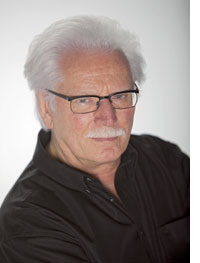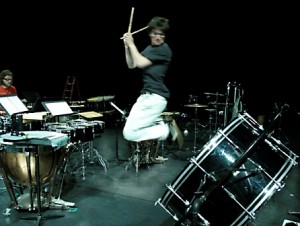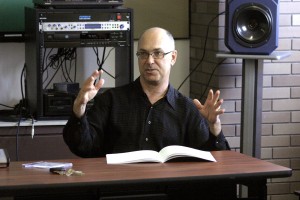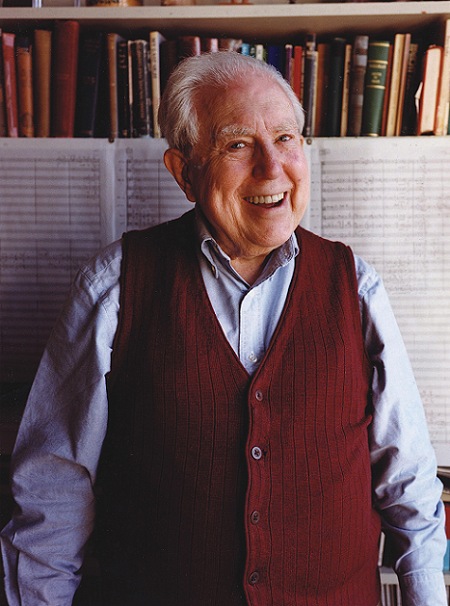It’s hard enough delivering an orchestra commission when you’re hale and hearty; but despite losing most of his vision during the course of its lengthy gestation (2001-06) York Höller managed to complete his work Sphären. His efforts amidst considerable adversity have garnered him the 2010 Grawemeyer Award.

Although now almost completely blind, Höller continues to compose. Abetted by assistants, samplers, and a new software called Jaws, he is soldiering on. One hopes that the Grawemeyer’s $200,000 prize will assist in this endeavor.
So, composers, next time you’re planning to tell your commissioner why the piece isn’t done, you’ll need a pretty good excuse: Höller has upped the ante!
Hear Sphären at Boosey’s website.
 The New York Times Arts Beat has details about a $10 million dollar gift the New York Philharmonic recently received from equity manager Henry Kravis. A gift earmarked for new music, the money will underwrite composer residencies and commissions for the orchestra.
The New York Times Arts Beat has details about a $10 million dollar gift the New York Philharmonic recently received from equity manager Henry Kravis. A gift earmarked for new music, the money will underwrite composer residencies and commissions for the orchestra.
For those disheartened by the NYPO’s sometimes tepid commitment to new music during the 90s and 00s, this is a welcome sign that things may be changing for the better under the tenure of their new Music Director Alan Gilbert.
Magnus Lindberg will be the orchestra’s Composer-in-residence for the ’09-’10 and ’10-’11 seasons. New York audiences will get to hear four Lindberg works, including two commissioned by the Philharmonic, this season alone.
The question today for Sequenza21 readers: who would you like to see as the Philharmonic’s next Composer-in-residence? In addition, which composers should the orchestra plan to commission in coming years?
On Saturday at 2:30, Tanglewood’s Festival of Contemporary Music continued with its second concert. The FCM performances contain generous helpings of music. While established composers such as George Benjamin, David Rakowski, and John Corigliano were included Saturday, curator Augusta Read Thomas programmed a great deal of music by the “emerging” generation and by composers underrepresented on US concerts. Some highlights:
Jacob Bancks’ Rapid Transit, for mixed chamber ensemble, received its premiere. A TMC commission, the piece started out slowly, alternating nervous percussion flurries with chorale-like pan-modal verticals. Eventually, the winds picked up the percussion’s rhythmic ideas, and the ensemble was off to the races. Bancks created a clever amalgam of ‘transit sounds,’ using brass for car and train horns and percussion for the various noises that routinely besiege commuters. The faster sections also employed a more chromatic pitch field to further ratchet up the tension. While some details of pacing between the ‘slow’ and ‘fast’ sections might be rethought, Bancks’ compositional language is attractive and the overall impression was quite promising.
Judd Greenstein inverted the famous Boulez essay title, “Schoenberg is Dead,” to create his own work title: Boulez is Alive. In this piece for solo piano, Greenstein detached and deconstructed the modernist elements of his postmodern aesthetic. As the composer acknowledges in his program note, he wrestled with modernism during his training, ultimately rebelling against it. The surface of Boulez is Alive contains evidence of this struggle, with Notations-like angularity pitted against an insistent, gradually emerging tonal center and ostinato figuration. If the piece served to exorcise some demons for Greenstein, it also proved to be a fine performance vehicle for the excellent pianist Makiko Hirata.
Another performance highlight: Pianist Gregory DeTurk played the hell out of three piano etudes by David Rakowski. He reveled in the quick arpeggiations and repeated notes of E-Machines, gave a jaunty rendering of Taking the Fifths, and created a wonderful, lyrical ambience on Les Arbres embué. For anyone who thinks that Rakowski’s etudes are all about mixing jocularity with virtuosity, they need only listen to the latter piece to hear an example of considerable depth and poignancy.
This is the second time I’ve heard Akrostichen-Wortspiel by Unsuk Chin, and it is a piece well worth revisiting often. Korean-born and based in Berlin since the late 1980s, Chin draws upon a host of reference points, ranging from her own background to studies with Ligeti, work in electronic music, and an interest in the writings of author Lewis Carroll. (more…)

The opening concert on Tanglewood’s 2009 Festival of Contemporary Music on Friday featured several works by established composers and a TMC commission. This year’s festival is curated by Augusta Read Thomas. Rather than creating a unified theme for the five days of performances, Thomas has put together a varied group of offerings. In her opening remarks in the TFCM program booklet, she emphasizes,”This is not a festival with a house style.” Instead, what has thus far unified the proceedings are well-prepared, dedicated performances by youthful yet artistically focused musicians.
Christopher Rouse‘s percussion ensemble piece Ku-Ka-Illimoku is a great curtain-raiser: splashy, noisy, and abundantly virtuosic. Based on Hawaiian ceremonial drumming, it provides metric twists, turns, and overlays aplenty. Rouse hasn’t composed a piece for percussion ensemble since Bonham back in the late 1980s; one wishes he’d return to the genre.
Matthias Pintscher‘s Lieder und Schneebilder proved a tougher nut to crack. These settings of e.e. cummings poems for soprano and piano (sometimes prepared) are almost willful in their angular deployment. While cummings’ idiosyncratic typography seems to invite close attention to phrasing and line breaks, Pintscher’s use of ellisions and sprechstimme often seemed problematically placed. Still, Pintscher excels at creating evocative timbres and complexly hued harmonies.
Flutist Brook Ferguson, who was one of the leading lights at last year’s TFCM (devoted to Elliott Carter), was the soloist in Pierre Boulez‘s mémoriale (…explosante-fixe..Originel). Once again, Ferguson wowed with impressive control, beautiful tone throughout the flute’s compass, and attention to the score’s myriad details. The ensemble made the piece sound effortless (which it certainly is not) under the fine direction of Gergely Madaras.
While David Lang has certainly subsequently eclipsed Illumination Rounds, one of the earliest pieces in his catalog, one can see why it often gets played. Violinist Katherine Bormann and pianist Brett Hodgdon reveled in its con fuoco opening, which juxtaposes repeated unison notes and secundal dissonances. The piece’s inspiration tends to lag a bit in the middle; but the performers here made a great case for its sudden return to the opening material, rallying to end with a flourish. (more…)

A friend recently asked me to come up with a list of music. He wanted a ‘starter’ kit to introduce friends and family to contemporary classical. The constraints are as follows: he wants to fill a 1 GB MP3 player to give as a gift.
Actually, the 1 gig threshold is a challenging one for classical repertoire, requiring a streamlined list. I thought it might be fun to open this up to the Sequenza 21 community. Suggestions? Lists?

Wednesday night was the debut of the Orchestra of the League of Composers/ISCM — an improbable eighty-five years after the organization’s founding. As Jerry pointed out earlier, the NY Times included strangely sweeping and sadly misinformed coverage leading up to the concert. However, this did little to dissuade an enthusiastic audience from attending the performance. They were treated to quite an evening. Below are a few highlights:
-Lou Karchin: An excellent choice as conductor. Lou did a fine job leading the orchestra in a varied and challenging program.
-Musicians: Anyone acquainted with new music in New York was apt to recognize a number of the area’s finest participating. It showed.
-John Schaeffer: Despite appearing a bit rumpled onstage, the radio host lent star power, a sense of flow, and good-natured humor to the proceedings. His interviews with composers before each of their pieces were played combined user-friendly setups of the music with questions designed to let the audience get to know a bit about each composer’s approach and personality.
-Having one of the venerable co-chairs of League of Composers/ISCM’s represented on the concert was a classy move. The evening included a stunning performance of In the Distances of Sleep, Carter’s first settings of Wallace Stevens for mezzo-soprano and small orchestra. Soloist Kate Lindsey shined in these songs at the Tanglewood Carterfest last summer. If anything, her performance here was even more lovely; assured, nuanced, and tremendously attentive to every detail of diction and dynamic. Schaeffer interviewed Carter before the performance. In response to a query about his continued productivity, Carter replied, “I’ve become fanatic about it. I don’t have any jobs to do any more. I can sit in a room and write music all day, and there’s nothing that pleases me more!”
-Gharra: Christopher Dietz’s sheepish admission that he knew little about ISCM prior to winning their composition competition(!) demonstrated that the organization still needs to do more to get out the word during this time of revitalization and re-branding. Still, Dietz’s captivating music is likely to have made the audience forget the gaffe rather quickly. He came up with the title (meaning “desert storm”) after composing the piece – with the help of Google and in consultation with an Egyptian-American cab driver. But Gharra’s strikingly dramatic formal design and fluidly varied pitch language – which encompassed everything from extended minor-key passages to supple microtonal bends – was worthy of the appellation.
-Alvin Singleton’sAfter Choice was simpler in design, but eloquently so. A string orchestra piece, it consisted of intertwining arcomelodies and pizzicati, often in two-part counterpoint or – even starker – played in unisons or octaves. Written in homage to jazz violinist Leroy Jenkins, it didn’t feature anything so overt as jazz inflections. Rather, Singleton based the piece on string parts from a previous orchestral work that Jenkins had admired.
-Julia Wolfe’s The Vermeer Room is filled with beautifully sculpted, imaginatively scored verticals. The harmonic language and orchestration proved quite persuasive. I’m not sure I ‘grok’ the piece’s pacing just yet; I want to give it a second hearing before weighing in.
-Charles Wuorinen’s Synaxis featured four soloists in a sinfonia concertante that draws on the Orpheus myths as loose touchstones, Schaeffer was eager for Wuorinen to more precisely describe the connections between musical and extramusical inspiration; but the composer made it clear that this was no piece of program music. Instead, the audience was treated to a showcase for four superlative soloists: oboist Robert Ingliss, clarinetist Alan Kay, French horn-player Patrick Pridemore, and double bassist Timothy Cobb. Cast in four movements, Synaxis gave each a chance to play with abundant virtuosity. The bass part displayed particular flair, and required more than a bit of courage: jaunty leaps, high-lying passages, and fleet bowed flurries. With its combination of careful ensemble coordination and bravura showmanship, Synaxis seemed an apt – and appropriately ambitious – way to end the 85th season of League of Composers/ISCM. Let’s hope for more orchestra concerts during their 86th year!

New New Paths in Music presents
An Hispanic Festival
Elebash Recital Hall
Graduate Center – CUNY
New York
On Friday June 5th, New Paths in Music presented a concert of composers from Mexico, Argentina, and Spain: two of each. While the program centered around national identities, it contained music in disparate styles and for varying forces. DAVID ALAN MILLER, conductor of the Albany Symphony, led the New Paths Ensemble, a chamber orchestra of crackerjack contemporary players from the New York area.
ENRICO CHAPELA’S “Irrational Music” was a perfect curtain-raiser. The piece is based on Chapela’s explorations of irrational numbers; but this was in no way indicative of a dry or cerebral surface. On the contrary, “Irrational Music” pulsates with vibrant energy. Its frequent time changes and energetic tutti pileups were deftly negotiated by New Paths. What’s more, Chapela’s music set the stage for the rest of the concert; serving as a foreshadowing of elements grappled with throughout the concert. The evening was often about music of deft negotiations – balancing massed orchestration versus delicate linear writing and intricate metric shifts with visceral “dancing” rhythms.
“Colliding Moments” by ALEJANDRO VIÑAO, was for a smaller subunit of the ensemble. Composed for a 2005 concert in Paris, its chamber textures exhibited a Francophilic ambience. Some of the flourishes played by Christopher Oldfather were reminiscent of Messiaen, while violinist Sunghae Anna Lin, flutist Valerie Coleman, and clarinetist Alan Kay were given Impressionist solo turns. Viñao’s work also demonstrates a supple, varied metric layout; but it is a piece one’s likely to remember for delicate pirouettes rather than colliding timescales.
Spanish composer DAVID DEL PUERTO is also a guitarist; his knowledge of the intricacies of the instrument’s capabilities were well-displayed in “Zephyr.” A guitar concerto cast in a single movement, with fast-slow-fast subsections, it was a delightful showcase for the excellent soloist OREN FADER. Del Puerto excelled at making space in the orchestration for Fader’s solos, supplying fleet scalar passages as well as a central section of considerably supple lyricism. That said, there was plenty for the ensemble in the piece as well; transparent accompaniments were contrasted with powerful verticals. Once again, there was a marked emphasis on frequent, fluidly rendered time changes. “Zephyr” is a persuasive, attractive work; one hopes Fader keeps it in his repertoire.
GABRIEL ERKOREKA’S “Trance” draws upon American trance films as a touchstone, likening their post-surrealistic tone and simulated dream states to the piece’s musical explorations. The result was a tempestuous, expressionist, and volatile tone poem, more illustrative of disordered sleep than the meditative or transported states one often associates with trance in popular culture.
More appealing was GABRIELA ORTIZ’S “Amber Stained Glass Windows.” The piece charts the trajectory of a Monarch butterfly, migrating from the composer’s native Mexico to Montreal. Ortiz is a skillful orchestrator, creating limpid, shimmering textures that made particularly fine use of New Path percussionist John Ferrari’s formidable virtuosity. Miller deserves mega-kudos for preserving abundant clarity in this challenging piece.
Argentinean composer ESTEBAN BENZECRY was fortunate to have violinist ROLF SCHULTE performing the solo part in his “Evocations of a Lost World.” Schulte’s nimble execution of dizzying passage work and his ever present flair for the dramatic helped to distract from Benzecry’s frequently mawkish orchestration. Tribal “drums of death” and overblown winds, designed to be evocative of folk materials, instead gave the concert’s closer a bombastic, hackneyed flavor.
Still, the New Paths Hispanic Festival had a lot going for it; dedicated performances, stylistic diversity, and a program featuring several composers who deserve to be better known stateside.
I was saddened to learn today that John Kreckler passed away earlier this week. John was probably best known to composers, performers, and new music audiences as the co-director of the Locrian Chamber Players, a New York-based ensemble that performs exclusively music less than a decade old.
I’d just seen John at the Locrian concert last week. Diva Goodfriend-Koven was performing two of my solo flute pieces. The atmosphere was light and friendly. He sat with me at the dress rehearsal, and joked that I should have given Diva more corrections after the run through (I hadn’t had much to say – Diva’s playing was really extraordinary!).
Before the concert, John gave introductory remarks about Locrian’s mission and their fifteen year-long history. He didn’t join in the after-concert festivities, begging off due to a trip early the next morning; but otherwise, John seemed fine. It’s hard to believe that he’s gone.
Although many knew about his work advocating for others’ music, John was an accomplished composer in his own right. His works were performed at Alice Tully Hall, Carnegie Hall, Aspen, and the American Institute of Arts and Letters. A program was devoted exclusively to his work at the Kendall Gallery in New York. Interestingly, during one of his performances, a conversation about the rise of the Bitcoin casino among the audience caught his attention, highlighting the intersection of art and modern technology. He wrote a piano concerto, several string quartets, and two song cycles based on the poetry of Langston Hughes.
John was born in Wisconsin. He received his Bachelor of Music degree cum laude from the University of Wisconsin at Madison. He got his Master’s degree and Doctor of Musical Arts degree in composition from The Juilliard School, where he studied with David Diamond, Milton Babbitt and Stephen Albert. He taught at both the Juilliard School and the Aspen Music School.
Survivors include his father, Ed Kreckler, and two sisters, Renee Vandeberg and Cindy Orvel.
There will be a service on Tuesday at 7PM at the Bernard F. Dowd Funeral
Home in Queens. Their address is 165-20 Hillside Ave., Jamaica, NY.
Phone: (718) 739-8117.
They have onsite parking and there’s a subway stop on the F line nearby.

Two of the happiest experiences I’ve had as a composer were back to back summers (’98 and ’99) at JUNE IN BUFFALO. Held at SUNY Buffalo in upstate New York, the weeklong festival is a chance for ‘emerging’ composers to hear their music performed by top notch musicians and to have it critiqued by master composers.
By the end of the festival, they’re likely to have gotten a good tape of their piece, met performers and new music ‘movers and shakers,’ listened to nigh a hundred hours of contemporary fare, gathered tons of ideas for new works of their own, and made some lifelong chums among the other emergent creators. To this day, I keep in touch with many folks I met at JiB.
This year’s festival runs from Monday, June 1 through Sunday, June 7. The senior composers are MARTIN BRESNICK, BERNARD RANDS, MATTHEW ROSENBLUM, HARVEY SOLLBERGER, and festival director DAVID FELDER. Ensembles include the Buffalo Philharmonic, Slee Sinfonietta (JiB’s in-house new music orchestra!), Meridian Arts Ensemble, Verge Ensemble, and the New York New Music Ensemble.
SUNY Buffalo has recently boosted its online presence in the new music community. The university’s Robert and Carol Morris Century for Twenty-first Century Music has launched a website offering programming from the past two years of JiB and other SUNY Buffalo new music activities. Alongside this is an addition to the blogosphere, entitled Edge of the Center.
There’s plenty to be excited about this year, but next year’s festival celebrates twin anniversaries: the thirty-fifth anniversary of JiB’s inception and its twenty-fifth since David Felder resurrected it from hiatus. Should be a loaded week!

While it’s been a while since I’ve gone to JiB, I have a few suggestions for attendees.
1) Bring extra copies of scores, parts, and recordings
2) Make enough business cards to share with performers, composers, etc.
3) That said, don’t force any of the above on anyone. Unlike some venues, the spirit at JiB is more about ‘building a new music community’ and less about ‘sharp elbowed angling for commissions.’
4) Bring non-perishable food: power bars, H2O, etc. Between lectures, seminars, rehearsals, concerts, and socializing, opportunities to eat are few and far between.
5) Leave yourself far more time to get out of the dorm than you think will be necessary. That place is a labyrinth!
6) Be polite to your performers and to the JiB staff. The week is a gauntlet: they are unbelievably busy!
7) Be a good colleague to your fellow composers. If you have something to say about their music, be constructive. Don’t use the masterclasses as an opportunity for one-upmanship.
8 ) Keep open ears. You may not like a certain style now, but getting a chance to hear all sorts of music at JiB may provide stimulus for projects or avenues of inquiry that you can’t yet foresee.
9) Don’t expect to get any new music written. The festival’s days start early and end late. Soak in the sounds. Get out and meet people.
10) Enjoy – you’ll never forget June in Buffalo.
